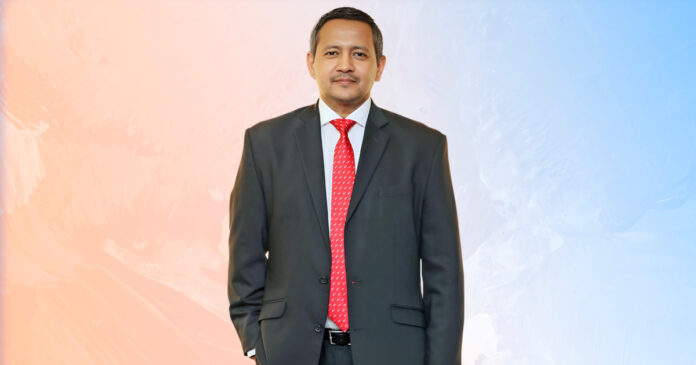Indika Gunawardena is a seasoned professional with over 26 years of corporate experience, including extensive leadership roles in Information Technology. As the current Vice President-IT and Chief Information Officer (CIO) at National Development Bank PLC (NDB), Indika is a key member of the bank’s leadership team, playing a pivotal role in driving the bank’s IT strategy to align with its vision of being the banking group of choice.
Indika is a Fellow of the Chartered Institute for IT (UK), a Chartered IT Professional, and a Fellow of Chartered Professional Managers (FCPM). With two MBAs and an MSc in Information Security, Indika brings a wealth of knowledge and expertise to his role. His career is marked by business-critical assignments and a strong track record of delivering value-driven IT strategies.
Before joining NDB in 2020, Indika served as the Group Chief Information Officer for LAUGFS Group of Companies, where he was responsible for the overall ICT and digital operations, ensuring business value delivery through technology.
Indika’s journey at NDB has been instrumental in transforming the bank’s IT landscape, and his dedication to innovation continues to shape the bank’s digital future.
Q. How has the role of the CIO in financial institutions evolved from being primarily technical resources to strategic collaborators, innovators, and integrators?
The role of the CIO in financial institutions has evolved from focusing solely on IT systems to becoming a key player in optimising processes and driving business transformation. Today’s CIOs are champions of process standardisation and digitisation, ensuring that manual workloads are streamlined through automation and digital solutions. This shift not only enhances efficiency but also empowers internal teams to be more agile and capable.
CIOs are no longer just maintaining IT infrastructure; they are implementing governance frameworks to ensure alignment with regulatory standards and business objectives. By focusing on IT governance and certifying processes like Information Security, business continuity and Service Management, CIOs establish strong foundations for long-term operational excellence. They are also building internal capabilities, reducing dependency on external vendors, and fostering a culture of innovation within the organisation.
This transformation emphasises the importance of standardisation, digitisation, and internal capability-building, positioning CIOs as strategic collaborators who drive efficiency and ensure that technology investments deliver real business value.
Q. Can you discuss a recent example where collaboration between CIOs and customer-facing departments improved the customer experience across multiple delivery channels?
“A customer support experience that’s smooth across every single platform.” That’s the result of collaboration between the CIO’s team and customer-facing departments at NDB. Together, we developed a Customer Support Request Management (CSRM) platform that not only tracks and manages customer interactions across digital and physical channels but also delivers a seamless experience across the board.
This wasn’t just a typical IT fix—it was a strategic win. By working hand-in-hand with the customer experience department, IT team ensured that every touch point, whether online, in-person, or via call centres, felt consistent and efficient. It’s a shining example of what happens when IT team goes beyond the tech desk to drive real change through close partnership with business departments.
Q. How are CIOs driving innovation within back-office systems to enhance overall efficiency and improve customer experiences, and what challenges do they face in this process?
In today’s financial world, innovation starts in the back office. As a CIO, streamlining operations isn’t just about adopting shiny new tech—it’s about embedding automation and standardisation into the heart of processes to unlock real business potential. Certifying processes in Information Security, Business Continuity, and Service Management through ISO27001, ISO22301, and ISO20000 helps ensure that everything runs like a well-oiled machine.
Digitisation has been a game-changer. Once-manual tasks are now automated, freeing up teams to focus on strategic projects that drive the business forward. The result? Faster processes, reduced operational costs, and a customer experience that’s smoother than ever. But, of course, innovation doesn’t come without its bumps. The biggest challenge lies in integrating new technologies with legacy systems. CIOs must also strike a balance between automation and human involvement—because no matter how advanced the system, human intuition is sometimes irreplaceable. The key is flexibility: ensuring that systems can scale, adapt, and innovate while enhancing efficiency and improving customer satisfaction.
Q. What strategies do CIOs employ to effectively integrate legacy systems with new technologies, and how does their involvement in the planning process impact the success of such integrations?
Successfully integrating legacy systems with modern technology isn’t just about getting the old and new to talk to each other—it’s about orchestrating a seamless, harmonious blend. CIOs are like the conductors in this symphony, leveraging APIs, middleware, and cloud services to bridge the gap between outdated systems and cutting-edge technology, all while ensuring minimal disruption.
But the magic starts in the planning process. CIOs dive deep from the outset, ensuring that the IT strategy aligns with the organisation’s business goals. This early involvement allows them to anticipate potential hurdles, allocate resources wisely, and ensure the integration process is smooth. By having a clear roadmap, CIOs can navigate the maze of integration, balancing innovation with the reliability that legacy systems provide. It’s a delicate approach, but when done right, it lays the foundation for a tech ecosystem that’s not only efficient but future-ready.
Q. How are CIOs utilising enterprise data and analytics to personalise product offerings and drive business growth, and what collaborative efforts are necessary to turn data insights into actionable strategies?
CIO’s team is using data and analytics to really get to know customers and help offer them personalised products that meet their specific needs. By applying tools like advanced analytics, they can analyse large amounts of data to identify trends and suggest create products that customers are likely to embrace. For example, predictive analytics helps businesses figure out which customers would benefit from certain products, which can boost satisfaction and growth.
However, making sense of all this data isn’t a solo effort. IT teams work closely with teams from marketing, product development, and customer experience to turn these data insights into practical actions. It’s essential that the right data governance and security measures are in place to ensure data is accurate and protected. By fostering collaboration and focusing on data-driven strategies, IT can help organisations improve customer experiences and fuel growth.
Q. What specific measures are CIOs implementing to strengthen cybersecurity in financial institutions, and how do they balance the need for robust security with the demand for seamless customer experiences?
Cybersecurity is no longer just about building walls—it’s about constant vigilance. CIOs in financial institutions are stepping up their game with advanced threat detection systems, multi-factor authentication, and zero-trust architecture. But that’s just the start. Continuous monitoring and real-time threat intelligence ensure that banks stay one step ahead of cybercriminals. Encryption, both in transit and at rest, is now a given when it comes to safeguarding sensitive customer information.
Yet, the challenge is balancing tight security with a user-friendly experience. No one wants to jump through endless hoops to access their bank account, so adopting sleek, user-friendly protocols like biometric authentication, which ensures both security and ease of use. Behind the scenes, teams are also working on optimising processes so that security measures don’t slow down transactions or impact service availability. This ensures a seamless blend of robust security and effortless customer experience—one that keeps customers happy and their data safe.


